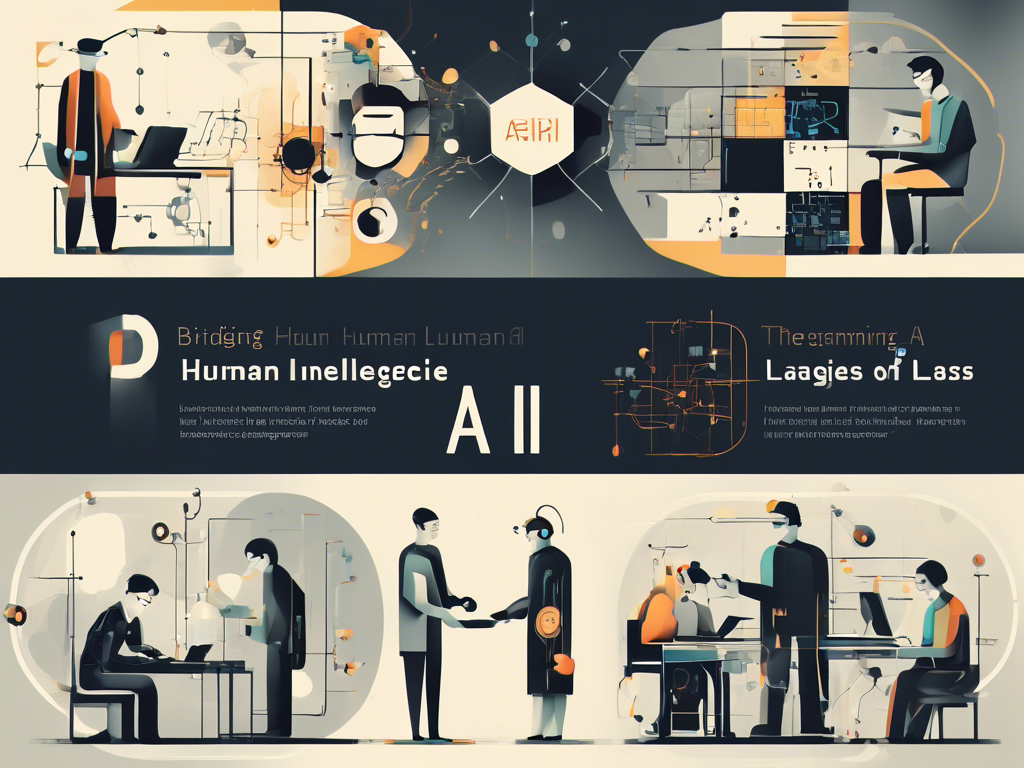In the dawn of a new technological era, Artificial Intelligence (AI) emerges as a testament to human ingenuity, a domain where complex algorithms mimic cognitive functions that humans associate with other human minds. But beneath the sophisticated capabilities of AI lies its true enabler: the programming languages that power these intelligent systems. Like the blood coursing through the veins of a living organism, programming languages fuel the decision-making processes and learning capabilities that define AI.
The impact of language choice on AI development is monumental, influencing everything from ease of implementation to the potential for innovation. Whether it’s the versatility of Python, the function-level precision of Lisp, or the myriad of other options available, selecting the right language is a pivotal decision that can spell success or setback for AI projects.
As we delve deeper into this relationship, we witness a stunning evolution – a symbiotic journey where both AI and programming languages have grown and adapted in tandem. This evolution not only traces back the milestones in AI advancements but also highlights the transformative role of programming languages in bridging the gap between human intelligence and artificial counterparts.
This article sets the stage to explore the intricate dynamics of this relationship, providing insights into how the backbone of AI – its programming languages – serves as a critical factor in the burgeoning field of artificial intelligence.
Understanding the Backbone: How Programming Languages Power AI

The Role of Programming Languages in AI Development
Programming languages serve as the foundational tools enabling developers to create sophisticated Artificial Intelligence (AI) systems. They are the medium through which humans communicate complex algorithms and instructions to machines. Selecting the right programming language is crucial for the efficiency, scalability, and success of an AI project. Languages like Python, Java, and R have become synonymous with AI development due to their simplicity, flexibility, and robust libraries that streamline the development process. These languages offer rich ecosystems of frameworks and libraries, such as TensorFlow for Python, that significantly reduce the time and effort required to implement complex AI models.
Moreover, the choice of a programming language can directly impact the performance and capabilities of an AI system. For instance, Python’s extensive collection of machine learning libraries and its easy-to-understand syntax make it ideal for prototyping and rapid development, features quintessential for the fast-paced evolution of AI technologies. On the other hand, languages like C++ are chosen for scenarios where execution speed and resource efficiency are critical, despite the increased complexity in coding.
Optimizing AI with the Right Programming Tools
The optimization of AI algorithms and their effective deployment hinges not just on the theoretical foundations of machine learning but also significantly on the practical capabilities provided by programming languages and their associated toolkits. Advanced optimization techniques, such as deep learning, require extensive computational resources and highly optimized code to run efficiently. This necessity has led to the rise of specialized frameworks and libraries designed to harness the power of hardware accelerators like GPUs and TPUs, providing the computational speed necessary for training complex models.
Additionally, the interoperability between different programming languages and tools plays a pivotal role in the AI development ecosystem. It allows for the integration of various components developed in different languages into a cohesive system, enhancing both flexibility and functionality. For example, a data preprocessing module written in Python might be integrated with a high-performance model inference engine written in C++, combining Python’s ease of use with C++’s speed. Thus, understanding the strengths and limitations of each programming language and selecting the appropriate tools are imperative for developers aiming to push the boundaries of what AI can achieve.
In conclusion, programming languages are more than just a means to instruct computers; they are the building blocks that empower AI to solve some of the most complex challenges facing the world today. The strategic selection of programming languages and tools not only defines the developmental trajectory of AI projects but also their potential impact on society. As AI continues to evolve, so too will the languages and tools at its foundation, driving innovation and opening new frontiers in technology and human potential.
Programming Languages and Their Role in AI Development
Decoding AI Success: The Impact of Language Choice on Development
The impact of programming language choice on the development of AI systems cannot be overstated, serving as a pivotal element in the success or failure of AI projects. The selection of a programming language influences not just the developmental efficiency but also the performance and scalability of the final AI model. For instance, languages like Python are lauded for their extensive libraries and frameworks, such as TensorFlow and PyTorch, which facilitate rapid prototyping and are instrumental in the exploratory phase of AI development. On the other hand, C++ and Rust might be favored in scenarios demanding high performance and memory efficiency, critical for large-scale AI applications.
Furthermore, the adaptability of a programming language to AI’s evolving landscape plays a crucial role. As AI technologies push forward, languages that support easy integration with new tools and libraries become invaluable. This adaptability enables developers to incorporate cutting-edge technologies and methodologies into AI systems without overhauling the foundational codebase. Consequently, the initial choice of programming language can significantly influence the long-term scalability and maintainability of AI projects, impacting the ability to meet future demands and integrate advanced AI functionalities.
Language Ecosystems and Community Support in AI Development
The ecosystem surrounding a programming language, inclusive of libraries, frameworks, and community support, acts as a force multiplier in AI development. A robust ecosystem provides developers with tools and resources to tackle complex problems more efficiently, reducing development time and increasing the robustness of AI models. For example, Python’s rich ecosystem offers a plethora of libraries for machine learning, data analysis, and visualization, making it an attractive choice for developers and researchers alike.
Equally important is the community support associated with a programming language. A vibrant community contributes to a comprehensive documentation, a plethora of tutorials, and forums for troubleshooting, which are invaluable resources, especially when developers encounter unique challenges or need to adopt new technologies. Additionally, strong community support often leads to the creation of third-party libraries that extend the functionality of the primary programming language, further enriching its application in AI development.
In essence, the choice of programming language in AI development extends beyond mere syntax or performance metrics; it encompasses the broader ecosystem and community support, both of which are critical for nurturing innovation and facilitating the successful implementation of AI projects. As the field of AI matures, the interplay between programming languages and their ecosystems will undoubtedly play a central role in shaping the future trajectory of AI technologies.
From Python to Lisp: Navigating the Best Programming Languages for AI

Python: The Gateway to AI Development
Python’s prominence in the Artificial Intelligence (AI) and machine learning (ML) arenas is no accident. Its syntax simplicity, coupled with a vast library ecosystem such as TensorFlow, PyTorch, and Scikit-learn, makes it an unparalleled choice for beginners and experts alike. These libraries not only streamline the development process but also encapsulate complex algorithms into more manageable functions, significantly reducing coding time and potential errors. Moreover, Python’s readability ensures that developers can share and collaborate on code with ease, fostering a community of continuous improvement and innovation. The language’s adaptability allows for the easy integration of new tools and methodologies, making it ideal for the evolving landscape of AI technologies. Through these strengths, Python has established itself as the lingua franca of AI development, accessible to a wide range of projects from simple automation scripts to intricate neural network designs.
—
Lisp: The Classic Choice for AI
Despite being one of the oldest programming languages, Lisp occupies a special place in the history and development of AI. It was initially designed for symbolic computation, offering features such as recursion, conditional expressions, and the ability to manipulate source code as a data structure. These capabilities made Lisp ideal for the prototyping of AI algorithms in the early days, particularly in the realms of problem-solving and natural language processing. What sets Lisp apart is its unparalleled flexibility — programmers can easily modify the language’s syntax or write code that generates other code, features that are immensely beneficial in AI projects requiring extensive experimentation. While not as popular as Python in today’s AI landscape, Lisp’s influence is undeniable, and it remains a powerful tool for certain niche applications and for those who appreciate the depth of control and historical significance it offers to AI development.
In navigating the best programming languages for AI, developers must consider factors such as project requirements, scalability, and community support. Python stands out for its ease of use, extensive libraries, and large community, making it an excellent starting point for most AI endeavors. On the other hand, Lisp offers unmatched flexibility and a rich heritage in AI development, appealing to those tackling highly specialized or innovative projects. Ultimately, the choice of programming language is a foundational decision that influences the trajectory of AI development, underscoring the importance of selecting a language that aligns with the project’s goals and the team’s expertise.
The Evolution of AI and Programming Languages: A Symbiotic Journey
From Assembly to Artificial Intelligence: The Shifting Sands of Programming Paradigms
The relationship between Artificial Intelligence (AI) and programming languages is one of continuous evolution, marked by the shifting sands of technological paradigms. In the early days of computing, programming was predominantly carried out in languages like Assembly or Fortran, which, while powerful for their time, presented significant challenges for the development of AI due to their complexity and low level of abstraction. As the quest for intelligent machines advanced, the emergence of higher-level languages like Lisp and Prolog marked a pivotal shift. These languages offered features such as pattern matching, tree-based data structures, and automatic garbage collection, which aligned well with the needs of AI research, particularly in symbolic processing and knowledge representation.
This era also witnessed the advent of object-oriented programming (OOP), embodied by languages like Smalltalk and later Java, which further influenced AI development. OOP’s emphasis on objects as the fundamental unit of computation, along with its encapsulation and inheritance mechanisms, provided a new lens through which AI systems could be designed, promoting modularity and reusability. These advancements underscored a key aspect of the symbiotic journey between AI and programming languages: as AI’s ambitions expanded, the need for languages that facilitated more natural, efficient, and expressive ways to model and solve complex problems became increasingly apparent.
—
Modern AI and the Dominance of Python: A Love Story
In the contemporary landscape, Python’s ascent to the pinnacle of AI development is a testament to the enduring interplay between programming languages and AI. Python’s simplicity and readability, combined with its rich ecosystem of libraries like TensorFlow, PyTorch, and NumPy, have made it the go-to choice for developers and researchers alike. Its dynamic nature and the support for interactive computing via Jupyter notebooks have further solidified its position as the lingua franca of modern AI. But the story doesn’t end there. The evolution of AI and programming languages is an ongoing narrative, punctuated by the rise of domain-specific languages (DSLs) such as TensorFlow’s Keras API for neural networks, which abstract away the complexities of underlying algorithms, making it even easier for non-experts to build sophisticated AI models.
However, Python’s dominance does not imply the obsolescence of other languages. For example, Rust is gaining traction in scenarios where memory safety and performance are paramount, and Julia is carving out its niche in high-performance numerical and scientific computing. These developments highlight the symbiotic nature of the evolution between AI and programming languages: as AI continues to push the boundaries of what’s possible, programming languages evolve to provide the tools necessary to realize these innovations. Conversely, advances in programming languages open up new avenues for AI research and application, creating a cycle of mutual advancement that drives the frontier of technology forward.
Programming Languages and Their Role in AI Development

Bridging Human Intelligence and AI: The Role of Programming Languages
The interplay between human intelligence and Artificial Intelligence (AI) is a complex, evolving relationship that sits at the heart of modern technological advancement. Programming languages are the critical bridge in this relationship, serving as the translators of human thought and ingenuity into machine-executable commands. The choice of programming language can greatly influence how effectively human intelligence can shape, direct, and refine AI systems.
On one hand, languages like Python have democratized AI development with their simplicity and extensive support for machine learning libraries. This has enabled a broad spectrum of users, from amateur enthusiasts to seasoned data scientists, to contribute to the AI landscape. On the other hand, languages such as Prolog and Lisp, with their roots in logic and symbolic processing, cater to more specialized AI tasks that require deep technical expertise. The diversity of programming languages available today allows for a multifaceted approach to AI development, where different types of human intelligence can find the most suitable linguistic tool to bring their ideas to life.
Moreover, the evolution of AI-specific programming languages and frameworks signifies a leap towards creating more intuitive ways for humans to interact with and command AI systems. For instance, domain-specific languages (DSLs) designed for neural network modeling aim to abstract the complexities of underlying algorithms, making it easier for developers to focus on crafting innovative AI models. This progression towards more accessible and expressive programming tools reflects a growing understanding of how crucial human-centric design is in the advancement of AI technologies.
The Future of AI Development: Language, Design, and Collaboration
Looking ahead, the role of programming languages in AI development is expected to evolve beyond mere syntax or functionality. As AI systems become increasingly integrated into everyday life, there is a growing need for programming languages to encompass principles of human-computer interaction (HCI), ethical AI usage, and collaborative development practices. This entails not just technical enhancements to languages to support more powerful and efficient AI models but also improvements in usability, documentation, and community engagement to encourage a broader, more diverse group of individuals to participate in AI development.
The incorporation of HCI principles into programming languages could lead to the creation of more intuitive and user-friendly development environments, where AI can be more effectively taught, tested, and refined by humans. Moreover, as ethical considerations become paramount in the deployment of AI technologies, programming languages will need to include mechanisms for transparency, fairness, and accountability by design. Lastly, fostering a collaborative environment where developers from various backgrounds can share knowledge, tools, and best practices will be crucial. This could be facilitated by enhanced language interoperability and shared frameworks that encourage cross-disciplinary innovation.
In essence, the future of AI development hinges not just on the technical capabilities of programming languages but also on how well they can adapt to and incorporate human values, ethics, and collaborative spirit. By bridging human intelligence with AI in a more inclusive, intuitive, and responsible manner, programming languages will continue to play a pivotal role in shaping the future trajectory of AI technologies and their impact on society.
Summing up
Throughout this insightful exploration, it has become evident that the choice of programming language is not merely a technicality but a foundational aspect that can propel AI towards groundbreaking achievements or hinder its progress. We have navigated the spectrum from Python to Lisp, each language contributing uniquely to the AI landscape. It’s a decision that carries the weight of potential, dictating the flexibility, efficiency, and even the very nature of the intelligence that is crafted.
The symbiotic journey of AI and programming languages reflects an ever-evolving narrative of innovation, with each leap forward in one field catalyzing growth in the other. As developers and innovators, our role transcends coding; it involves understanding how the fabric of these languages intertwines with the essence of artificial cognition.
As we stand at this convergence of human intellect and artificial prowess, programming languages do not just serve as tools but as bridges connecting two realms of intelligence. Our continued exploration and mastery of these languages will inevitably shape the future of AI, pushing boundaries and redefining what is possible. Thus, it behooves us to invest in a deeper comprehension and skillful application of these powerful linguistic constructs that hold the keys to unlocking the next era of AI breakthroughs.
